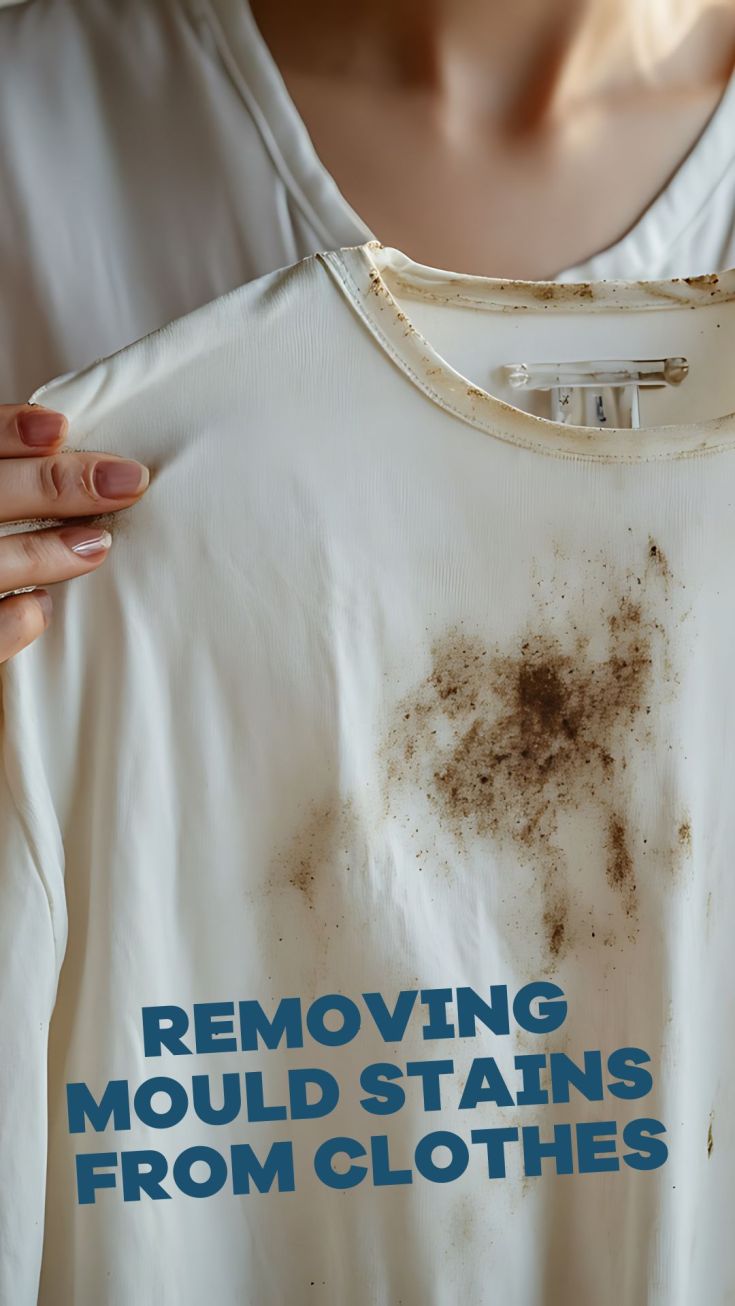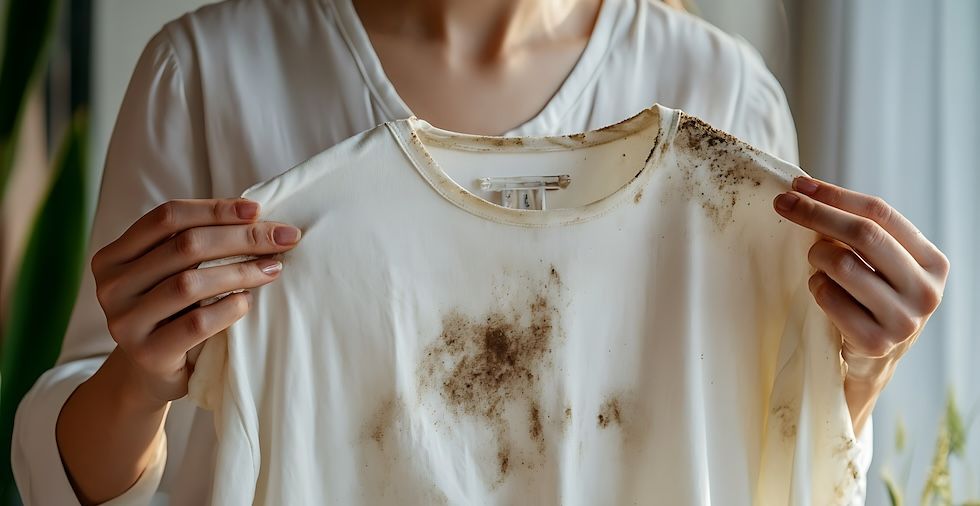- Why does mould grow on fabric?
- What are the best products to remove mould from fabric?
- Removing mould from fabric: simple steps
- How to remove mould from specific fabrics
- How to prevent mould growth on fabric: Tips
Finding mould on your clothing, curtains, or bedding can be stressful. It's not merely that it's unsightly. It can also have a nasty smell, trigger specific allergies, and even make you ill.
So, what should you do about it? The removal of mould from fabric can be challenging, but learning the correct process is the answer. Whether on clothing, curtains, upholstery, or a baby's pram, tackling mould quickly prevents it from spreading.
Luckily, we've got you covered. In the following guide, we'll look at everything you need to know about removing mould from fabric and stopping it from returning.
Why does mould grow on fabric?
Before we go any further, it's worth looking at the facts. Why does mould grow on fabric? Porous fabric and moisture provide the perfect environment for mould growth. Put simply, when your clothing is damp and left in the right place, mould grows on it.
Mould thrives in damp, warm, and poorly ventilated areas. For example, putting your clothes away while they are still damp and the wardrobe is warm could be the issue. The fabric absorbs moisture quickly, making it the perfect breeding ground.
Let's take a look at the breakdown of the common causes:
- Leaving wet laundry in the machine for too long
- Storing clothes in humid conditions
- Spills and stains that you don't clean up immediately
- Damp upholstery or curtains in poorly ventilated rooms
Spoiler: The longer mould stays on the fabric, the harder it is to remove. It can also weaken the fibres and leave permanent stains. For that reason, you must deal with the removal of mould from fabric quickly. The sooner you tackle this common problem, the better the results.
What are the best products to remove mould from fabric?
You may already have what you need in your home. Believe it or not, several household and commercial products can effectively kill mould and remove stains.
Here are some of the most reliable options:
Natural solutions
First, look at some of the more natural solutions you can use when removing mould from fabric. Here are some of the ingredients you may already have:
White vinegar
White vinegar can work wonders. This natural product can break down mould and quickly remove musty odours.
Baking soda
Similarly, baking soda can help with this problem. The powder naturally absorbs moisture and can remove stains.
Lemon juice and salt
Lemon juice and salt have natural bleaching effects. That means that this combination is often perfect for mould stain removal when you're dealing with lighter fabrics.
Oil of cloves
You may not have heard of this one, but oil of cloves kills mould spores and can help to prevent mould regrowth.
Commercial cleaners
Are you looking for something more intense? If you're looking for a tougher solution for your mouldy fabric, consider some of these everyday cleaning products.
Oxygen bleach
This type of bleach is safe for coloured fabrics. It's tough on stains and may help you to get rid of the mould from your fabric.
Hydrogen peroxide
Next, this commercial cleaning product kills mould and lifts stains without damaging the fibres. Before you get started, be sure to read the instructions.
Mould-removal sprays
Finally, some specific cleaning products have been designed for upholstery and fabric furniture. Once again, do your research and follow the instructions closely.
Removing mould from fabric: simple steps
Now that you understand which products you can use, let's talk about how you can remove mould from fabric items. Here's a quick rundown of the main steps you need to take:
Step 1: Brush off the loose parts
Start by removing any loose mould parts. If possible, take the fabric outside for this. Then, use a stiff brush to remove as much surface mould as possible. This prevents spores from spreading indoors during the cleaning process.
Step 2: Soak the fabric (optional)
If your fabric can be washed in the washing machine, the next step is to soak it for an hour in a mixture of one part white vinegar and three parts water. Of course, if you're dealing with more delicate items, you might want to skip this step.
Step 3: Use a cleaning solution
Next, you need to use a cleaning product of your choice. You can refer back to the products we've outlined above. Depending on the fabric type, apply one of the following:
White vinegar
In this case, spray the vinegar directly onto the stain and let it sit for 30 minutes.
Baking soda paste
Mix the baking soda with water and scrub gently into the fabric.
Hydrogen peroxide
Take extra care here. Dab onto the stain and leave for 10-15 minutes before rinsing.
Step 4: Wash the fabric
Now that you've treated the fabric, you can wash it. Machine wash your items on the hottest setting that is safe for the specific type of fabric.
When setting up your wash, you can use a mould-killing detergent. Alternatively, add a cup of white vinegar to the rinse cycle.
Step 5: Let the fabric dry naturally
You should dry the fabric in direct sunlight if possible. That is because evidence suggests that UV rays kill mould spores.
Step 6: Repeat if you need to
If this process doesn't work the first time, you may need to repeat it. For stubborn mould stains, a second treatment may be necessary.
Note: You should always avoid using bleach on coloured fabrics as it can cause fading.
How to remove mould from specific fabrics
Now that you've got a basic overview of the removal of mould from fabric, let's dig deeper. Here are the ways that you can remove mould from specific types of fabric:
Clothing
Before washing, treat your clothing with white vinegar (or hydrogen peroxide). You should also avoid storing damp clothes.
Upholstery and fabric furniture
Use a mould-removal spray on fabric furnishings. Make sure the spray is suitable for upholstery.
Next, wipe your furniture with a cloth dipped in soapy water and vinegar. Then, thoroughly dry the items with a fan or dehumidifier.
Curtains
First, you'll need to take down your curtains. Then, soak them in a white vinegar solution. Next, wash your curtains according to their care instructions. Again, hang them in direct sunlight to dry.
Pram fabric
If mould grows on your pram, remove any fabric covers and wash them separately.
You should also wipe non-removable parts with a vinegar and water mixture. Make sure everything air drys completely before reassembling the pram and using it.
How to prevent mould growth on fabric: Tips
Now that you know how to remove mould from fabric, let's talk about how to protect it in the first place. Follow these simple pieces of advice.
- Never leave damp clothes or upholstery untreated.
- Open windows or use a dehumidifier in humid areas.
- Keep your clothes in dry, breathable storage spaces.
- Wash and air out fabric items frequently.
The removal of mould from fabric may sound tricky, but it doesn't have to be. Follow the advice we've shared in this guide to make sure that you get it right. You can use products you already have in your home or buy special mould-busting cleaning products instead.
Q&A
How do I remove black mould from fabric?
Black mould stains can be challenging to remove. Before washing, try treating them with hydrogen peroxide or oxygen bleach.
What's the best product to remove mould odour from fabric?
Does it smell nasty? Don't panic. White vinegar is the most effective option for neutralising mould smells. If vinegar doesn't work, you can also try baking soda.
How do I remove mould stains from coloured fabric?
Try using oxygen bleach or white vinegar to treat stains. These can help without damaging the fabric's colour. Always avoid chlorine bleach, as it can cause fading.
How can I clean mould from fabric furniture?
First, vacuum the fabric to remove loose spores that may spread. Then, clean the affected area with a mould-removal spray or a mix of vinegar and warm water.
What mouldy item are you cleaning? Let us know in the comments below!


Leave a Reply